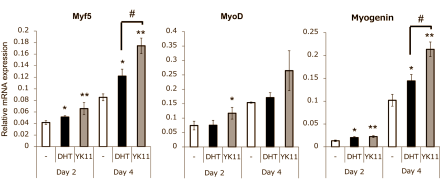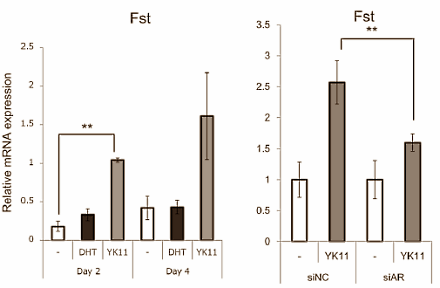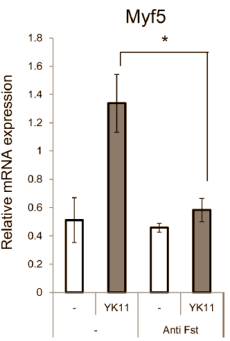

YK11 is a SARM and myostatin inhibitor in one
Japanese researchers are doing tests with a new SARM , which according to the first publications has a stronger anabolic effect than a classic anabolic steroid such as DHT. YK11 attaches itself to the androgen receptor, produces few androgenic effects and inhibits - in a way that the researchers do not understand - the effect of myostatin
You can see YK11 above. If you click on the picture, a larger version will appear. It is a strange molecule that cheerful chemists probably once made while enjoying home-brewed ethanol, and then forgot. The Japanese found him when they screened compounds for androgenic properties. The whole thing is called (17-alpha, 20E) 17.20 - [(1-methoxyethylidene) bis (oxy)] 3-oxo-19-norpregna-4,20-diene 21-carboxylic acid methyl ester .
PubMed only has two studies into YK11. [PubMed: YK11] The researchers get their money from a prestigious government fund for young up-and-coming talent. If you get money from such an institution, you are not going to suffice with two publications, but you will be helping a whole mountain of publications into the world. We will hear more about YK11 soon.
In 2011, Yuichiro Kanno of Toho University published a first study on YK11, in which he demonstrated that the brand value connection was a SARM. YK11 attaches itself to the androgen receptor, but initiates in cells only to a limited extent the processes that can lead to the classical side effects of androgens, such as the growth of body hair, the increase of the aggression and growth of the prostate.
Most SARMs have relatively few androgenic side effects, but often - if you compare it with a substance such as testosterone - relatively little anabolic effect. At YK11 that may be different, Yuichiro Kanno reported in 2013 in Biological and Pharmaceutical Bulletin.
https://sarms-peptide.shop/

In that research, Kanno experimented with C2C12 muscle cells, and not with test animals or humans. Nevertheless, Biological and Pharmaceutical Bulletin found Kanno's article valuable enough to bomb it into a " Highlighted Paper selected by Editor-in-Chief ". That's no wonder. Kanno discovered that muscle cells produce more anabolic factors if you expose them to 500 nanomoles of YK11 than if you expose those same muscle cells to 500 nanomoles of DHT.

And take a look. YK11 provides a greater increase in the production of Myf5, MyoD and myogenin than DHT. Myf5, MyoD and myogenin are signal proteins that make muscles grow.
The figure below shows how that is possible. YK11 makes muscle cells produce more follistatin - considerably more than DHT. Follistatin is a strong myostatin inhibitor.


If the researchers switched off the androgen receptor, YK11 lost its anabolic effect. YK11 therefore works via the androgen receptor. If the researchers switched off follistatin, the anabolic effect also disappeared. Proof supplied: YK11 is a SARM and a myostatin inhibitor .
Good old testosterone also stimulates the production of follistatin. [Endocrinology. 2009 Mar; 150 (3): 1259-68.] Maybe with YK11 we have a substance in our hands that is just as good a muscle enhancer as testosterone, but without the side effects.
" YK11 was shown to be an appropriate anabolic SARM, " the researchers write. " However, further investigation is required to elucidate the mechanisms of the differential activation of the follistatin pathway by YK11 and DHT ."
Regulation of myogenic differentiation by androgens: cross talk between androgen receptor/ beta-catenin and follistatin/transforming growth factor-beta signaling pathways.
Singh R1, Bhasin S, Braga M, Artaza JN, Pervin S, Taylor WE, Krishnan V, Sinha SK, Rajavashisth TB, Jasuja R.
Author information
1Division of Endocrinology and Research Centers in Minority Institutions Core Laboratory, Charles Drew University of Medicine and Science, Los Angeles, California 90059, USA. [email protected]
Abstract
Androgens are important regulators of body composition and promote myogenic differentiation and inhibit adipogenesis of mesenchymal, multipotent cells. Here, we investigated the mechanisms by which androgens induce myogenic differentiation of mesenchymal multipotent cells. Incubation of mesenchymal multipotent C3H 10T1/2 cells with testosterone and dihydrotestosterone promoted nuclear translocation of androgen receptor (AR)/beta-catenin complex and physical interaction of AR, beta-catenin, and T-cell factor-4 (TCF-4). Inhibition of beta-catenin by small inhibitory RNAs significantly decreased testosterone-induced stimulation of myogenic differentiation. Overexpression of TCF-4, a molecule downstream of beta-catenin in Wnt signaling cascade, in C3H 10T1/2 cells significantly up-regulated expression of myoD and myosin heavy chain II proteins and of follistatin (Fst), which binds and antagonizes native ligands of the TGF-beta/Smad pathway. Gene array analysis of C3H 10T1/2 cells treated with testosterone revealed that testosterone up-regulated the expression of Fst and modified the expression of several signaling molecules involved in the TGF-beta/Smad pathway, including Smad7. Lowering of testosterone levels in mice by orchidectomy led to a significant decrease in Fst and Smad7 expression; conversely, testosterone supplementation in castrated mice up-regulated Fst and Smad7 mRNA expression in androgen-responsive levator ani muscle. Testosterone-induced up-regulation of MyoD and myosin heavy chain II proteins in C3H 10T1/2 cells was abolished in cells simultaneously treated with anti-Fst antibody, suggesting an essential role of Fst during testosterone regulation of myogenic differentiation. In conclusion, our data suggest the involvement of AR, beta-catenin, and TCF-4 pathway during androgen action to activate a number of Wnt target genes, including Fst, and cross communication with the Smad signaling pathway.
PMID: 18948405 PMCID: PMC2654730 DOI: 10.1210/en.2008-0858
Selective androgen receptor modulator, YK11, regulates myogenic differentiation of C2C12 myoblasts by follistatin expression.
Kanno Y1, Ota R, Someya K, Kusakabe T, Kato K, Inouye Y.
Author information
1Faculty of Pharmaceutical Sciences, Toho University.
Abstract
The myogenic differentiation of C2C12 myoblast cells is induced by the novel androgen receptor (AR) partial agonist, (17α,20E)-17,20-[(1-methoxyethylidene)bis-(oxy)]-3-oxo-19-norpregna-4,20-diene-21-carboxylic acid methyl ester (YK11), as well as by dihydrotestosterone (DHT). YK11 is a selective androgen receptor modulator (SARM), which activates AR without the N/C interaction. In this study, we further investigated the mechanism by which YK11 induces myogenic differentiation of C2C12 cells. The induction of key myogenic regulatory factors (MRFs), such as myogenic differentiation factor (MyoD), myogenic factor 5 (Myf5) and myogenin, was more significant in the presence of YK11 than in the presence of DHT. YK11 treatment of C2C12 cells, but not DHT, induced the expression of follistatin (Fst), and the YK11-mediated myogenic differentiation was reversed by anti-Fst antibody. These results suggest that the induction of Fst is important for the anabolic effect of YK11.
https://sarms-peptide.shop/


